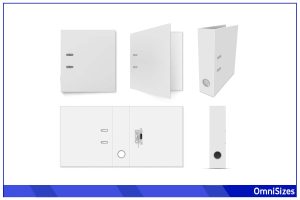Batteries power everything from remote controls to life-saving medical devices. Battery sizes match the right power source to the right gadget to ensure that devices operate effectively. This simple component is more complex than it appears, as sizes vary widely and are designed for specific functions.
The dimensions of the most common battery sizes are as follows:
- AAA: 0.41 × 1.75 inches (1.04 × 4.45 centimeters)
- AA: 0.57 × 1.97 inches (1.45 × 5 centimeters)
- C: 1.02 × 1.81 inches (2.6 × 4.6 centimeters)
- D: 1.34 × 2.28 inches (3.3 × 5.8 centimeters)
- 9V: 0.69 × 1.04 × 1.91 inches (1.75 × 2.65 × 4.85 centimeters)
This guide will provide the dimensions of an even greater list of battery sizes, as well as explain the technical aspects and applications of these tiny yet highly meaningful sources of portable power.
A Deep Dive Into Battery Sizes

Batteries come in various shapes and sizes. Battery sizes are not just about the physical dimensions; they also define the power and life span of the batteries.
Basics of Battery Dimensions
When you hear ‘AA’ or ‘AAA,’ these aren’t just random letters but specific sizes. An AA battery is larger and typically lasts longer than a AAA. The dimensions of a battery are crucial because they must fit into the device’s battery slot.
Common Battery Size Classifications
| Battery Size | Shape | Length (mm) | Length (in) | Width (mm) | Width (in) | Height (mm) | Height (in) |
| AAAA | Cylindrical | 8 | 0.31 | 8 | 0.31 | 42 | 1.65 |
| AAA | Cylindrical | 10.5 | 0.41 | 10.5 | 0.41 | 44.5 | 1.75 |
| AA | Cylindrical | 14.2 | 0.56 | 14.2 | 0.56 | 50 | 1.97 |
| C | Cylindrical | 26 | 1.02 | 26 | 1.02 | 46 | 1.81 |
| D | Cylindrical | 33 | 1.34 | 33 | 1.34 | 58 | 2.28 |
| 9V | Rectangular | 26.5 | 1.04 | 17.5 | 0.69 | 48.5 | 1.91 |
| CR123 | Cylindrical | 17 | 0.67 | 17 | 0.67 | 34.5 | 1.36 |
| CR2 | Cylindrical | 16 | 0.63 | 16 | 0.63 | 27.5 | 1.08 |
| N | Cylindrical | 12 | 0.47 | 12 | 0.47 | 30.2 | 1.19 |
| J | Rectangular | 36.5 | 1.44 | 9.18 | 0.36 | 48.5 | 1.91 |
| Group 24 | Rectangular | 260 | 10.23 | 173 | 6.81 | 225 | 8.86 |
| Group 27 | Rectangular | 306 | 12.04 | 173 | 6.81 | 225 | 8.86 |
| Group 31 | Rectangular | 330 | 12.99 | 173 | 6.81 | 240 | 9.45 |
| Group 34 | Rectangular | 260 | 10.24 | 173 | 6.81 | 200 | 7.87 |
| Group 35 | Rectangular | 230 | 9.06 | 175 | 6.89 | 225 | 8.86 |
| Group 51 | Rectangular | 238 | 9.37 | 129 | 5.08 | 223 | 8.78 |
| Group 65 | Rectangular | 306 | 12.05 | 190 | 7.48 | 192 | 7.56 |
| Group 78 | Rectangular | 260 | 10.24 | 179 | 7.05 | 196 | 7.72 |
Technical Aspects of Battery Sizes
Battery sizes affect not only whether a battery will fit in your device but also how long it can run it.
1. Voltage and Capacity
Voltage and capacity are like the horsepower and fuel tank of a car. Voltage, measured in volts, drives the device’s engine. The capacity, measured in milliampere-hours (mAh), tells you how much energy the battery holds. For example, AA batteries typically have a voltage of 1.5V and can range from 1700 to 3000 mAh.
2. Chemistry Behind Battery Sizes
The chemistry of a battery dictates its size, energy density, and how it behaves in different conditions.
- Alkaline batteries are common and inexpensive, suitable for low-drain devices like remote controls.
- Lithium batteries, while more costly, perform better and have a longer lifespan, making them ideal for high-drain devices like digital cameras.
- Nickel Metal Hydride (NiMH) batteries are rechargeable and offer a middle ground, being more cost-effective over time than disposables.
Battery chemistry impacts the size and power output. Lithium-ion batteries are powerful and compact, allowing smartphones to be slim yet potent. Alkaline batteries are larger for the same power, which is why they’re not used in compact tech like smartphones.
3. Performance Comparison Between Common Sizes
Different battery sizes deliver different performance levels. Smaller AAA batteries are lightweight and fit in small devices but don’t last as long as larger AA batteries under the same conditions. D batteries, being larger, hold more energy and are preferred for devices requiring long-lasting power without frequent changes.
Battery Sizes and Their Applications
Batteries have distinct sizes based on how much power they supply and what they’re designed to power.
Everyday Devices and Their Battery Needs
Remote controls, wall clocks, and children’s toys often rely on AA or AAA batteries—sizes that are small but mighty, perfect for gadgets that are handled frequently. These batteries are the most searched and bought due to their widespread use in household items.
Industrial Uses of Various Battery Sizes
In industrial settings, size C and D batteries are common. They fit into emergency equipment like flashlights and portable radios, offering the endurance needed for long shifts or situations where power sources are scarce.
Specialty Batteries for Medical and Military Equipment
Special devices need special batteries. For life-critical medical devices like pacemakers, button cells are used because of their reliability and compact size. Military gear often uses specific, sometimes custom, battery sizes designed for endurance and resilience.
Rechargeable vs. Disposable Batteries
Rechargeable batteries, such as Nickel-Metal Hydride (NiMH) and Lithium-Ion (Li-Ion), can be used over and over again, simply by recharging them when they run out. They tend to have a higher upfront cost compared to disposable batteries but can save money over time.
Benefits of Rechargeable Batteries
Rechargeable batteries are eco-friendly since they reduce waste. Devices like cameras, which drain batteries quickly, benefit from rechargeables due to their higher capacity and ability to sustain power over long periods.
The Convenience of Disposable Batteries
Disposable batteries, like alkaline or lithium disposables, are readily available and can be used immediately upon purchase without the need for charging. They are ideal for low-drain devices like remote controls and wall clocks.
Cost Comparison
While disposable batteries are cheaper upfront, rechargeables have a lower total cost of ownership since they can be used many times. It’s estimated that a single rechargeable battery can replace hundreds of disposables.
Lifespan of Rechargeable vs. Disposable Batteries
Rechargeable batteries have a finite number of charge cycles but can last for 2-7 years. Disposables can sit unused for longer periods without losing charge, so it’s generally a good idea to have a few on hand for emergency situations.






